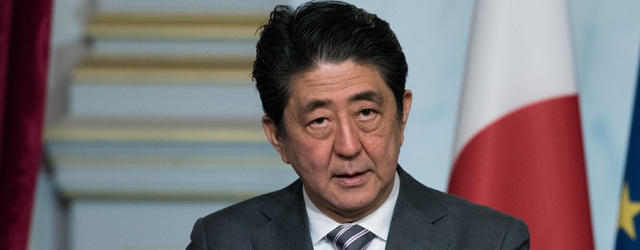US withdrawal from the TPP was a shock to its top ally in the Pacific, and may push Japan into the trading arms of China.

Although it had been flagged throughout Donald Trump’s presidential campaign, the tearing up of the Trans-Pacific Partnership trade accord soon after Trump’s election unnerved many Asian countries. Not least among these was Japan, which had portrayed the TPP as a key element of its long-term growth strategy.
The radical policies of Japanese prime minister Shinzo Abe, dubbed “Abenomics,” which aim at combating years of economic stagnation by generating inflation in the Japanese economy, had as a crucial element the implementation of the TPP. Indeed, the TPP was at the core of the “third arrow” of reform Abe envisioned for the Japanese economy, providing support for the structural reform that is supposed to exist alongside the first two arrows of fiscal stimulus and monetary policy easing. It seems it will not be possible to fire those three arrows in the face of the collapse of the TPP.
But the reality may be rather different than expected. In what appeared to be a somewhat precocious ambush of the Trump administration, prime minister Abe sought a meeting with the president-elect just weeks before his inauguration. Commentators point to the apparent warmth of their relationship, and speculation is rife that the US and Japan may seek a bilateral trade agreement along the lines of the TPP.
That speculation seems premature. Japan is not supposed to be a supporter of a bilateral agreement with the US, due to what Tokyo had hoped to achieve from the TPP. That was to provide—with the crucial heavy lifting of the US—a counterweight to China through a range of trade deals with the accord’s signatories in Asia, including Singapore, Vietnam, Malaysia, Australia and New Zealand. The conciliatory stance of Japan toward the US within the TPP included concessions on agriculture and a drawn-out timeline for the removal of tariffs on Japanese automobile exports and light trucks, framed in the TPP to extend over 25 to 30 years.
That is seen by many TPP observers as having been a quid pro quo for the US’s counterweight inside the treaty in relation to China. Now that ballast has been removed following the Trump administration’s withdrawal from the TPP, Japan’s strategy toward trade relations with the US is more nuanced. The uncertainty casts a shadow over the annual meeting of the multilateral Asian Development Bank, which Japan is hosting in Yokohama in May. The ADB warned in December against rising protectionism, urging stronger trade linkages and greater foreign direct investment to improve countries’ economic resilience.
Charm offensives at president Trump’s Mar-a-Lago estate with prime minister Abe aside—the two met there for a summit in mid-February—the basic stance of the new administration was encapsulated by Commerce secretary Wilbur Ross in a paper jointly written with Peter Navarro, the newly installed director of the US National Trade Council in the Trump administration.
The duo stated: “According to textbook theory, balanced trade among nations should be the long-term norm, and the chronic and massive trade deficits the US has sustained for over a decade simply should not exist. This textbook state of balanced trade would exist because freely floating currencies would effectively adjust differences in national domestic cost structures to bring about balanced trade.”
From this position to the accusation of currency manipulation by Japan, with which the US has run trade deficits for the best part of 50 years—in 2016 the deficit was $68.9 billion, its second largest ever—is a short leap. However this might overstate the significance of US trade from Japan’s point of view. Indeed, one irony of the evaporation of the TPP is that it is likely to push Japan to embrace the China-backed Regional Comprehensive Economic Partnership, a conglomeration of regional trade pacts in Asia that the signatories of the TPP are likely to fall back on in the face of its demise.



